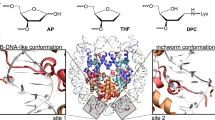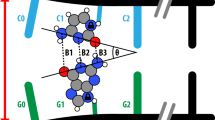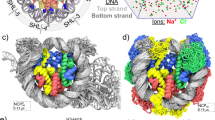Abstract
The nucleosome subunit of chromatin consists of DNA folded around a histone core as a 1.8-turn left-handed solenoid. The crystal structure1 of the nucleosome core particle revealed that it has a dyad symmetry axis and that the minor helix groove faces outwards from the protein core. Richmond et al.1 noticed that the path traversed by the helix has severe bends at sites approximately one and four helix turns from the dyad axis. We have developed two photochemical methods to study the structure of DNA, and in particular that wrapped around the nucleosome core. One method depends on the sensitization of singlet oxygen production by an eosin analogue. We have monitored the rate at which excited state oxygen diffuses into contact with DNA base planes, and find that it attacks the nucleosome with high specificity. We have also mapped the DNA binding of the intercalating dye methylene blue, and conclude that it binds to the same sites accessible to oxygen by diffusion. On the basis of these results we suggest that the DNA in the nucleosome is bent or kinked at two sites, 1.5 helix turns from the dyad axis.
This is a preview of subscription content, access via your institution
Access options
Subscribe to this journal
Receive 51 print issues and online access
$199.00 per year
only $3.90 per issue
Buy this article
- Purchase on Springer Link
- Instant access to full article PDF
Prices may be subject to local taxes which are calculated during checkout
Similar content being viewed by others
References
1. Richmond, T. J., Finch, J. T., Rushton, B., Rhodes, D. & KJug, A. Nature 311,532–537 (1984). 2. Freidman, T. & Brown, D. M. Nucleic Acids Res. 5, 615–622 (1978). 3. Berkoff, B., Hogan, M. E., LeGrange, J. & Austin, R. Biopolymers 25, 307–316 (1986). 4. Barkeley, M. D. & Zimm, B. H. /. chem. Phys. 70, 2991–3007 (1979). 5. Crick, F. H. C. & KJug, A. Nature 255, 530–533 (1975). 6. Wang, N. C., Hogan, M. E. & Austin, R. H. Proc. natn. Acad. Sci. U.S.A. 79,5896–5900 (1982). 7. Hogan, M. E., Hayes, B., Wang, N. C. & Austin, R. H. Biochemistry 25, 5070–5082 (1986). 8. Sobell, H. M., Tsai, C. C., Gilbert, S. G., Jain, S. C. & Sakore, T. D. Proc. natn. Acad. Sci. U.S.A. 73, 3068–3072 (1976). 9. Li, H. J. & Crothers, D. M. J. molec. Biol. 39, 461–477 (1969). 10. Lutter, L. C. Nucleic Acids Res. 6, 41–57 (1979). 11. McGhee, & Felsenfeld, G. Proc. natn. Acad. Sci. U.S.A. 76, 2133–2137 (1979). 12. Maniatis, T., Fritch, E. F. & Sambrook, J. Molecular Cloning, a Laboratory Manual (Cold Spring Harbor Laboratory, New York, 1982).
Author information
Authors and Affiliations
Rights and permissions
About this article
Cite this article
Hogan, M., Rooney, T. & Austin, R. Evidence for kinks in DNA folding in the nucleosome. Nature 328, 554–557 (1987). https://doi.org/10.1038/328554a0
Received:
Accepted:
Issue Date:
DOI: https://doi.org/10.1038/328554a0
This article is cited by
Comments
By submitting a comment you agree to abide by our Terms and Community Guidelines. If you find something abusive or that does not comply with our terms or guidelines please flag it as inappropriate.



